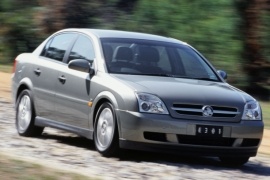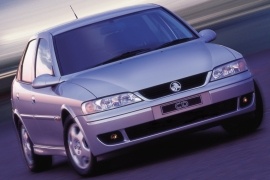HOLDEN Vectra Sedan Models/Series Timeline, Specifications & Photos
First production year: 1995
Engines: Gasoline, Diesel
Holden received the new generation of the European Opel/Vauxhall Vectra sedan in 2002 and unveiled it along with its hatchback sibling.
General Motors thought that a car designed for the European environment would do well on the Australian roads. There were only some mild changes to the bodywork and some technical modifications. The only engine designed and engineered specially for the Australian market was the 3.2-liter unit, which proved to be the most reliable.
The exterior featured a new design trend for its headlights, with a rectangular, swept-back look and a pair of headlamps inside. Its grille sported a horizontal slat and the round badge on it. In the liftback version, the Vectra featured a thick C-pillar and a straight, flat trunk lid. Like its European siblings, it sported corner-mounted taillights and a wide panel adorned by a chromed slat.
Inside, Holden had to stick with the European design and carried over all the parts from Vauxhall Vectra, which was built for the U.K. The base trim levels featured cloth upholstered seats, while the upper trim levels received a leather-clad interior. Holden offered a navigation system with a small screen placed between the center air vents from the dashboard. The comfortable bucket seats offered some bolstering.
Under the hood, Holden offered a wide choice of engines ranged from a four-pot 1.8-liter gasoline to a 3.2-liter V6. There were a few options for diesel-powered powerplants.
Holden introduced the Vectra in 1995 as a rebadged version for the European Opel/Vauxhall Vectra and made it available in a few body shapes.
GM used the Vectra nameplate in all the markets and all body shapes. It was available as a sedan, hatchback (liftback), and a station-wagon. GM considered that it would be better for the Australian factory to build the Holden Vectra liftback there and export it to other RHD markets in the area.
The 1995 Vectra was a major improvement over its predecessor with more rounded areas and fluid shapes. It looked like the GM partly agreed with the biodesign trend, but it didn't want to ditch it completely. A particular shape was for the door-mirrors connected to the bodywork via an aerodynamic pillar that followed the hood's V-shaped lines. Its curved lines were extended over the greenhouse and formed an arched shape ended with a third window behind the rear doors.
Inside, the bucket-seats at the front were mounted low on the floor to create the impression of a sporty family sedan. The concept worked well for the front passengers but left little legroom for the rear ones. GM installed a refreshed dashboard with curved lines that looked appealing to its customers. Depending on the trim level, the instrument cluster featured an additional LCD for the on-board computer installed next to the dials.
Under the hood, Holden offered the Vectra B with a choice of four gasoline and a turbodiesel engine. The carmaker paired all of them to a five-speed manual gearbox. For selected versions, the Vectra was available with a four-speed automatic.

